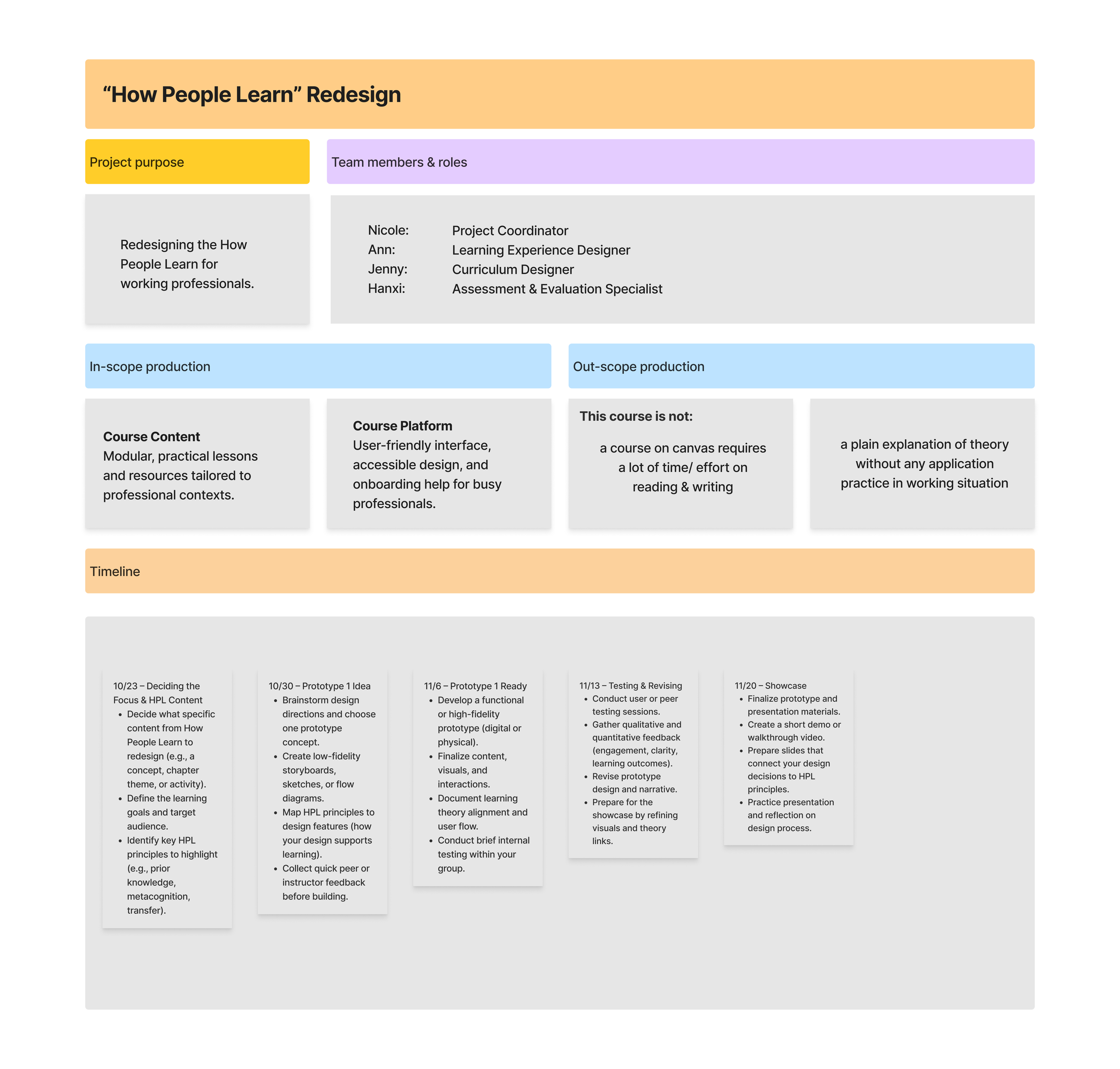Make a learning
impact today
Hire Ann as a learning experience designer!
Today’s Special (How’s Ann Special?)
Ann’s Learning Design Example
As part of the group redesigning the How People Learn course in the Teaching and Learning Lab Practicum, Ann focuses on developing two prototypes of the course—one using Articulate 360 and the other in a blog format.
Working Professionals Feedback on these two prototypes
“As someone who wants to learn about learning theory but isn’t particularly interested in reading dry academic material, I find edutainment-style blog posts a sustainable way to maintain my interest in learning over the long term.”
Chris C
“I really like the Articulate 360 platform with its flashcard design for learning those learning theories. It provides both convenience and depth. When I don’t have much time, I can quickly skim through the key concepts using the flashcards. When I do have more time, I can read the detailed explanations to understand how each concept can be applied in the workplace.”
L Huang
“I’m someone who reflects a lot on the way I learn. I find the explanations of those theories on the Articulate platform easy to read and helpful for my own reflection.”
T Fang
Learn more about Ann’s learning design process
Step 2: Understanding learners and develop user Persona
We conducted interviews with working professionals from both the U.S. and Asia, as well as expert interviews with learning designers from MIT and Harvard who have experience creating learning experiences for working professionals, to develop a deeper understanding of the learners we’re designing for.
Step 1: Developing a rolling agenda and project charter for team collaboration
Since the design team is composed of learning experience designers from diverse backgrounds and this project requires close collaboration, we developed an agenda and project charter to align our expectations and roles.
Learning Experience Design Reflection Posts
-
Food for Thought 1 🍦: What do Harvard courses, product design, and BerryLine froyo have in common?
While revisiting Behaviorism, Cognitivism, and Constructivism (Ertmer & Newby, 2013) to explore ways of redesigning the program for working professionals, I was struck by how these classic learning theories map directly onto how we design products:
🍓Behaviorism: “Behaviorism focuses on the importance of the consequences of those performances”. In other words, reinforcement matters. Clear signals, feedback loops, and measurable outcomes drive adoption and habits. Think of onboarding flows as a series of small rewards that guide intentional user actions.
🍓Cognitivism: In 1950, psychologists began to de-emphasize behavioral models and shifted toward understanding learners’ conceptualizations of how learned information is organized. In other words, structure matters. People need information organized in ways that make sense. That’s why we invest in clarity in the user experience so users can focus on truly rationalizing how the product works and building lasting mental connections with the product.
🍓Constructivism: Different from behavioral and cognitive theory’s objectivistic point of view, constructivism argues that learners actively construct knowledge through experience, reflection, and interaction. Context matters. True understanding comes from hands-on experience. Real value is created when users experience and explore the product. Features should enable exploration and personalization not just scripted paths. That’s where deeper learning, and long-term loyalty, happen.
For a lighter take, as a BerryLine fan in Boston (their original frozen yogurt with mochi is the best!!), I like to think froyo captures these three theories in one cup!
🍓Behaviorism is that instant reward when the first spoonful of BerryLine makes you want more.
🍓Cognitivism is knowing which toppings and flavors fit together because you’ve learned the patterns.
🍓Constructivism is experimenting until you find your own perfect mix.Combining these theories, products, or even something as simple as froyo, don’t just deliver functionality. They teach. They reinforce behaviors and empower discovery. As product designers, we don’t just create products; we’re creating learning experiences for our users.
-
📍Food for Thought #2: Designing for Inclusion at Scale
I approached the redesign of the course for working professionals through a guiding design principle rooted in human–computer interaction: accessibility as a foundation for equity. Every design choice aimed to make learning human-centered for all learners, including those with visual, auditory, motor, and cognitive differences.
✨ Accessibility by Design (aligned with WCAG 2.1 AA, ADA, and Section 508):
❗Perceivable: Added captions, transcripts, and high-contrast visuals with descriptive alt text for all media.
❗Operable: Ensured full keyboard navigation and logical tab flow.
❗Understandable: Simplified complex educational content and introduced consistent navigation patterns.
❗Robust: Verified compatibility with WAVE web accessibility evaluation tools as well as NVDA and VoiceOver using semantic HTML to ensure assistive technology support.
But accessibility doesn’t end with interfaces and it extends to how people participate, express themselves, and create meaning online. That belief also guided my earlier work at the AI for Social Good Lab, where I led a study on how visually impaired YouTubers navigate content monetization. I interviewed 12 creators across 4 continents and found innovative strategies for visibility and income, from reframing disability representation to leveraging YouTube as a credibility portfolio for offline opportunities.
Both experiences reaffirm a core belief: Inclusive design is not just about compliance. It is about creativity, empathy, and expanding what participation looks like in digital spaces.
The HCI research community has long explored how creators from marginalized communities, including LGBTQ+, Black, and transfeminine creators (Kingsley et al., 2022; Rodriguez, 2023; Harris et al., 2023; DeVito, 2022), as well as creators with disabilities (Choi et al., 2022; Borgos et al., 2019), navigate visibility, representation, and accessibility. An MIT research group I engaged with during a PhD interview had been exploring the limitations of existing web accessibility standards, particularly their tendency to offer only basic text or table alternatives for data visualizations, which restricts non-visual data exploration (Zong et al., 2022).
If you’re interested in diving deeper into this topic to design for equity and inclusion, I highly recommend checking out these incredible works and ongoing research in this space! -
-










